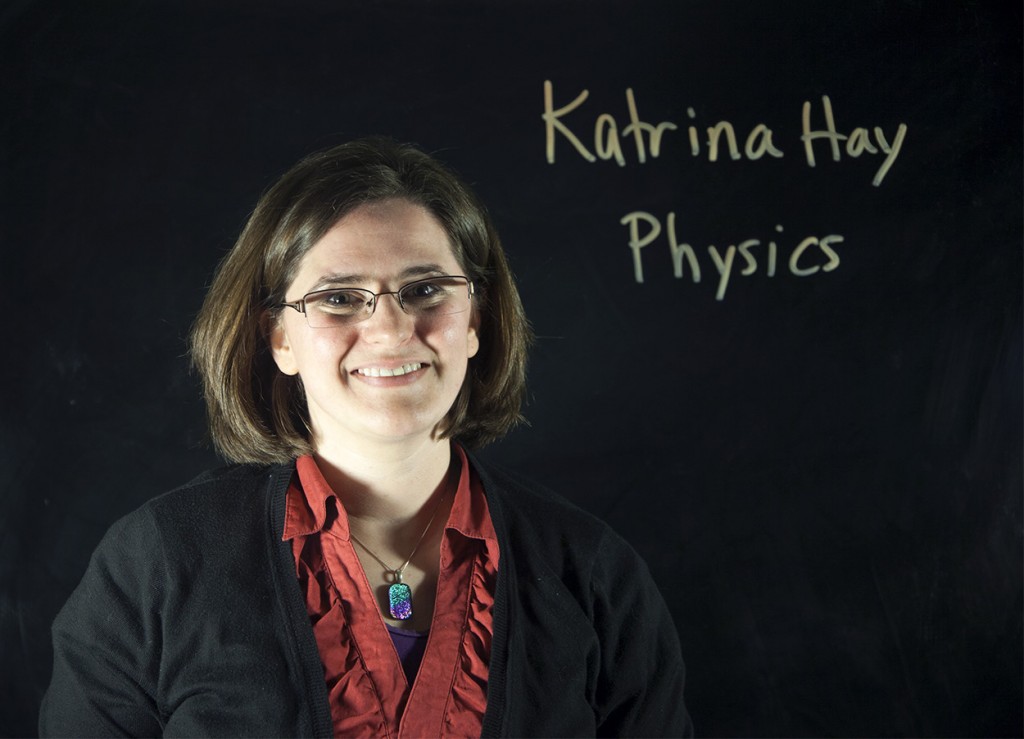
Katrina Hay, PhD
Division of Natural Sciences, Department of Physics
Lightboard for Instructional Videos
Katrina is an associate professor in the physics department, where she enjoys teaching a range of courses. Her research interests include fluid dynamics, observational astronomy and physics education research. At PLU, she has mentored undergraduate interns in fluid physics phenomenology and she is looking forward to working with students on observational astronomy research at PLU’s Keck observatory in Summer 2016. Katrina’s teaching is interactive in style, encouraging discussions, reflection and questions. Recently, she has been thinking about how to allow students to encounter challenging material in more ways, both inside and outside the classroom.
What is one instructional strategy or student project that is particularly effective, innovative, or engaging?
“I use a Light Board to make engaging videos for students to help them prepare for class. Introductory physics is a fast-paced tour of many conceptual and technical topics. It is helpful for students to encounter the most challenging material several times, in different ways, and in increasing levels of complexity. After speaking with colleagues Bret Underwood (Physics) and Justin Lytle (Chemistry) about the ways that they use online videos to motivate engagement with course material, I became interested in making my own videos. When I decided to create flipped-learning style videos for students to watch before class, I looked for a method that would let me speak directly to the viewer and still allow me to write out derivations and draw diagrams. That’s when I found the Light Board method. In it, video is filmed through a transparent plate. The presenter stands behind the plate and writes on it with bright markers. Against a black background, the writing is visible floating between the camera and presenter. The video is flipped right-to-left in post-processing so that viewers can read the writing normally (i.e. the presenter appears to be left-handed if they are right-handed and also appears to be skilled at writing backwards!).”
What supportive technology do you use to implement this strategy/project?
“I film with a standard video camera and process the clips in iMovie. I upload videos to YouTube and link them to my course Sakai website. To make the Light Board, I vertically braced a Plexiglas plate with boards and clamps to a table.”
What are the benefits, for you and your students, of using this strategy or tool?
“I wanted students to encounter material at least four different ways before being tested on it: in the reading, through a video, in class and on homework. I tried several methods for making video lectures that did not include a visual of myself. However, those videos did not authentically reflect my presentation style because I tend to speak animatedly with my hands. My facial expressions convey part of the message too. In addition, standing with my back to the camera and lecturing on a dry erase board also did not appeal to me because I wouldn’t easily make eye contact with the viewer and my body would partially block the writing. (And, pedagogically speaking, isn’t that the traditional lecture style that I was attempting to change to a different format in the first place?) For style continuity, and because of these concerns, I chose to make Light Board videos. Students can watch the videos at their own pace, pausing and re-watching as needed. They reflect on the material and submit online questions about it. I use their responses to create relevant class discussion and activities.”
What advice would you have for someone interested in trying this strategy or tool?
“There is no need to buy an expensive Light Board product, lit from within. You can build a simple desktop set-up with a Plexiglas plate, several boards for bracing and clamps to hold it in place. Use Expo Neon Window markers for the brightest writing. To make the image pop visually, wear mostly black clothes and stand in front of a black background. Light only the presenter, not the board. Darken the rest of the room so that the plate betrays no reflections of the surroundings. In iMovie, flip the video clip right-to-left (the students will ask you how you write backwards!), crop out distractions and enhance audio by eliminating background noise. Students will feel like they are sitting at your desk having a conversation with you.”



